
The flute is a family of musical instruments in the woodwind group. Unlike woodwind instruments with reeds, a flute is an aerophone or reedless wind instrument that produces its sound from the flow of air across an opening. According to the instrument classification of Hornbostel–Sachs, flutes are categorized as edge-blown aerophones. A musician who plays the flute is called a flautist or flutist.

An overtone is any frequency greater than the fundamental frequency of a sound. In other words, overtones are all pitches higher than the lowest pitch within an individual sound; the fundamental is the lowest pitch. While the fundamental is usually heard most prominently, overtones are actually present in any pitch except a true sine wave. The relative volume or amplitude of various overtone partials is one of the key identifying features of timbre, or the individual characteristic of a sound.
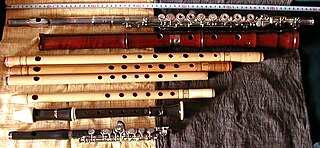
An aerophone is a musical instrument that produces sound primarily by causing a body of air to vibrate, without the use of strings or membranes, and without the vibration of the instrument itself adding considerably to the sound.

A shakuhachi is a Japanese and ancient Chinese longitudinal, end-blown flute that is made of bamboo.
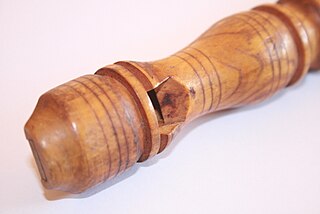
The term fipple specifies a variety of end-blown flute that includes the tin whistle and the recorder. The Hornbostel–Sachs system for classifying musical instruments places this group under the heading "Flutes with duct or duct flutes." The label "fipple flute" is frequently applied to members of the subgroup but there is no general agreement about the structural detail of the sound-producing mechanism that constitutes the fipple, itself.

A bansuri is a side blown flute originating from the Indian subcontinent. It is an aerophone produced from bamboo, used in Hindustani classical music. It is referred to as nadi and tunava in the Rigveda and other Vedic texts of Hinduism. Its importance and operation is discussed in the Sanskrit text Natya Shastra.
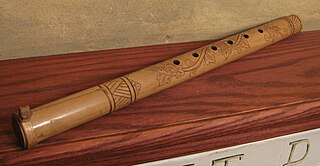
A suling or seruling is a Southeast Asian bamboo ring flute especially in Brunei, Indonesia, Malaysia, the Philippines and Singapore. It is used in Degung ensembles.
The venu is one of the ancient transverse flutes of Indian classical music. It is an aerophone typically made from bamboo, that is a side blown wind instrument. It continues to be in use in the South Indian Carnatic music tradition. In Northern Indian music, a similar flute is called bansuri. In the South, it is also called by various other names such as pullangkuzhal (புல்லாங்குழல்) in Tamil, oodakuzhal (ഓടകുഴൽ) or kurungu kuzhal in Malayalam (Kerala) and ಕೊಳಲು (koḷalu) or ಮುರಳಿ(muraļi) in Kannada (Karnataka). It is known as pillana grōvi or Vēṇuvu (వేణువు) in Telugu. It is also called as Carnatic Flute.
Prehistoric music is a term in the history of music for all music produced in preliterate cultures (prehistory), beginning somewhere in very late geological history. Prehistoric music is followed by ancient music in different parts of the world, but still exists in isolated areas. However, it is more common to refer to the "prehistoric" music which still survives as folk, indigenous or traditional music. Prehistoric music is studied alongside other periods within music archaeology.
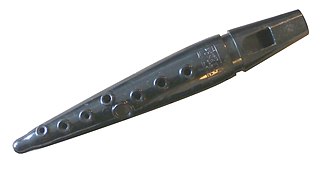
The stub-ended Swanson Tonette is a small, end-blown vessel flute made of plastic, which was once popular in American elementary music education. Though the Tonette has been superseded by the recorder in many areas, due to their price, durability and simplicity, plastic Tonettes are still in use in elementary schools around the nation. The range of the Tonette is from C4 to D5. A skilled player can produce notes above the principal register by overblowing and half-covering holes. Similar instruments are the Song Flute, Flutophone, and Precorder.
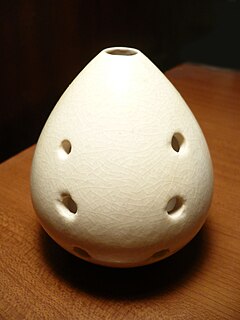
The xun is a globular, vessel flute from China. It is one of the oldest musical instruments in China and has been in use for approximately seven thousand years. The xun was initially made of baked clay or bone, and later of clay or ceramic; sometimes the instrument is made with bamboo. It is the only surviving example of an earth instrument from the traditional "eight-tone" (bayin) classifications of musical instruments.

The willow flute, also known as sallow flute, is a Nordic folk flute, or whistle, consisting of a simple tube with a transverse fipple mouthpiece and no finger holes. The mouthpiece is typically constructed by inserting a grooved plug into one end of the tube, and cutting an edged opening in the tube a short distance away from the plug.

An overtone flute is a type of a flute that is designed to play in the upper harmonics, typically well above the two or three harmonics that are the practical limit for most woodwind instruments.

A pipe is a tubular wind instrument in general, or various specific wind instruments. The word is an onomatopoeia, and comes from the tone which can resemble that of a bird chirping.

The Irish flute is a conical-bore, simple-system wooden flute of the type favoured by classical flautists of the early 19th century, or to a flute of modern manufacture derived from this design. The majority of traditional Irish flute players use a wooden, simple-system flute.
In music, the acoustic scale, overtone scale, Lydian dominant scale, Lydian ♭7 scale, or the Pontikonisian Scale is a seven-note synthetic scale.

The fujara originated in central Slovakia as a large sophisticated folk shepherd's overtone fipple flute of unique design. It is technically a contrabass in the tabor pipe class.

The frula, also known as svirala (свирала) or jedinka, is a musical instrument which resembles a medium sized flute, traditionally played in Serbia. It is typically made of wood and has six holes. It is an end-blown aerophone. The frula is a traditional instrument of shepherds, who would play while tending their flocks.
In music, the undertone series or subharmonic series is a sequence of notes that results from inverting the intervals of the overtone series. While overtones naturally occur with the physical production of music on instruments, undertones must be produced in unusual ways. While the overtone series is based upon arithmetic multiplication of frequencies, resulting in a harmonic series, the undertone series is based on arithmetic division.

The kalyuka is a Russian and Ukrainian overtone flute, lacking playing holes. Traditionally, kalyukas were made from hollow plant stems, such as motherwort, or angelica. Modern versions of the instrument are usually made from PVC, an inexpensive and durable substitute.

















